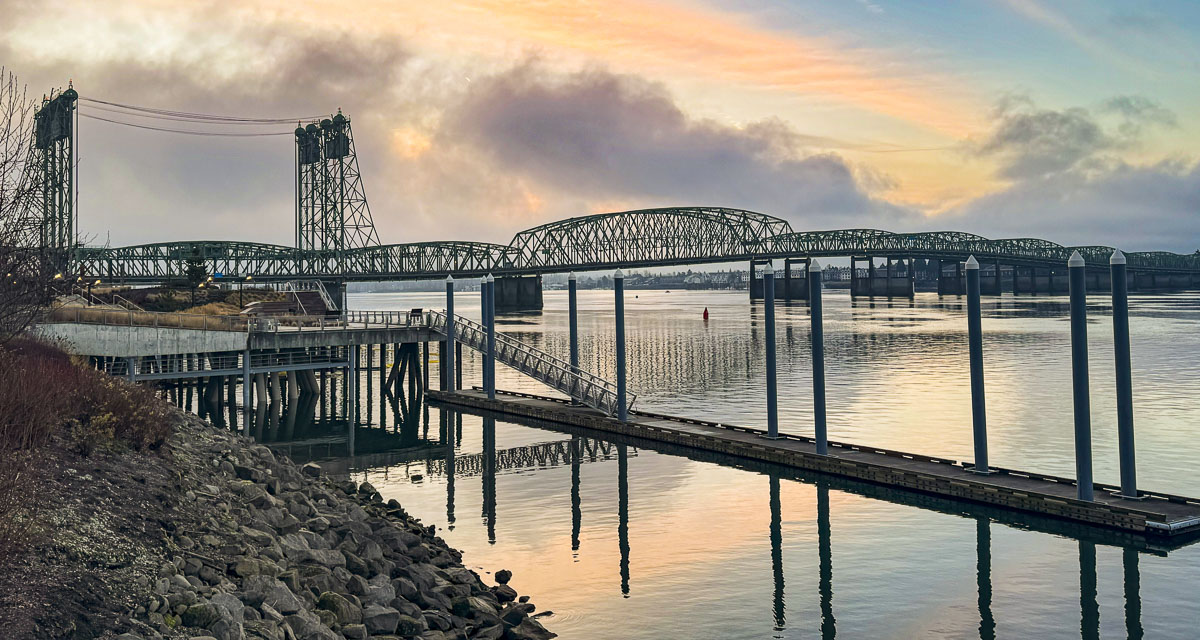
Camas resident Margaret Tweet discusses the proposed costs of the I-5 Bridge replacement project
Margaret Tweet
for Clark County Today
In 2005, the Columbia River Crossing Project (CRC) began with a 39-member CRC Task Force formed of leaders in Washington and Oregon from government agencies and selected groups. The Task Force met 23 times to advise the project team and concluded in 2008. They proposed the Locally Preferred Alternative, LPA, for an I-5 Bridge replacement that included extending TriMet MAX light rail from Oregon to Vancouver.

A range of alternatives were evaluated in the CRC Draft Environmental Impact Statement. When the Oregon Columbia River Crossing oversight committee met in Oregon in 2011, they asked about the bus alternative instead of light rail.
“CRC Deputy Director Kris Strickler said cost was a driving force behind presenting five different alternatives in the DEIS, some of which offered bus rapid transit instead of light rail.”
“At that time, cost was a factor,” Strickler said. “It was a driver in the discussion.”
See full report Oregon lawmakers say CRC project may be too expensive Issues , 2011
The current I-5 bridge has a vertical clearance of 178 feet. CRC proposed a bridge too low at just 95 feet with no lift for marine traffic, cutting off long time businesses that rely on adequate clearance to deliver products and services. The replacement bridge height design was raised to 116 feet, which could still adversely impact businesses in the region.
2012-A C-TRAN Proposition was put on the ballot to extend TriMet MAX Light Rail over the I-5 Bridge into Vancouver. Every city in Clark County and the county area allowed to vote rejected the proposition. Thousands of voters living outside city limits were excluded, although they pay the sales tax whenever they shop inside city limits where most businesses are located by zoning. Online sales also include sales tax.
2013-A County-wide Advisory vote was held to oppose any light rail project in Clark County unless it is first supported by a majority of voters in a county-wide vote of the people. Over 68% of voters approved.
2014: CRC failed to obtain enough support in Oregon and Washington legislatures to continue.
2019: CRC was revived as the Interstate Bridge Replacement Program, IBR. An audit of CRC revealed that WSDOT paid excessive profits to project consultants. IBR expenditures keep climbing, up to $194,691,922 thru December 2024, including lobbying in WA DC and WA state. IBR claims an opinion poll they purchased supersedes Clark County repeated votes against light rail. Community surveys indicate 78 percent of Washington residents and 70 percent of regional residents list traffic congestion and saving time as their top priority for the project.
For CRC, congestion was defined as travel speeds below 35 mph. ODOT and WSDOT are changing the definition of congestion to travel speeds below 45mph, the measure that IBR uses. This redefinition ensures that congestion will be worse on paper for IBR analysis. Updates to IBR travel demand, forecasts, and project costs are underway.
C-TRAN bus ridership declines over I-5 bridge:
IBR was considering bus transit options for the I-5 Bridge. However, expensive light rail was chosen, again. C-TRAN bus ridership peaked in 1999 at 7.75 million annual boardings that declined in 2019 to 5.9 million boardings. During Covid restrictions that began in March 2020, transit agencies saw significant declines in ridership. In 2020, C-TRAN bus ridership over the I-5 Bridge plummeted and remains well below 2019 levels.
Route reduction and consolidation leaves Route #105/105X I-5 Express to and from downtown Portland, and Route #190 Marquam Hill Express to and from OHSU. Route #60 Delta Park Regional buses go to and from downtown Vancouver to Jantzen Beach shopping area, and Delta Park MAX light rail station in Oregon, travelling southbound in shared lanes with other vehicles. C-Tran has funded and provided cross river bus service for decades without contribution from Oregon.
C-TRAN is funded primarily by local sales tax, $83,796,054 in 2023. Combined with State and federal grants, interest income, ~ $2.9 million in passenger fares, etc. 2023 Revenue shows $109,458,604. In addition, State and federal Capital Grants of $32,738,877 were added.
High Costs of Light Rail compared to Buses:
IBR I-5 Bridge current cost estimates = $5 to $7.5 Billion, cost hikes expected later in 2025.
MAX light rail over I-5 Bridge Construction Cost estimate for ~2-mile extension = $2 BILLION
TriMet Light Rail Annual Operations & Maintenance estimate*= $20,238,570
C-TRAN Express Bus O&M estimate *= $1,551,920
* Costs escalated to Opening Day FY2033 dollars at average inflation rate 4.5%
19 Light Rail vehicles at a cost of $10 -$15.2 Million each are in the IBR plan.
IBR graphic shows under 2% of trips use transit (lacks data year). IBR transit trips are similar to 2006 CRC, ~3,300 weekday daily transit passenger trips across Columbia River on I-5.
Existing Transit Ridership • CHAPTER 3 TRANSPORTATION 3-24
The emphasis IBR places on public transit, bicycles, and pedestrians above vehicles and freight has led to designs allocating over half of the IBR Bridge for transit, bicycles, walking. TriMet has a history of inflated light rail ridership estimates that are not met. Meanwhile, low initial cost estimates keep rising for MAX light rail extensions. Flexible C-TRAN bus service meets transit needs today, and can better adapt to future increases than fixed track light rail. Removing light rail will save at least $2 billion in construction costs, and reduce ongoing O&M costs substantially. We need affordable bridges to alleviate congestion and facilitate freight movement in the region. If this bloated public spending plan concerns you, please contact your local, state, and federal representatives right away as IBR planning and spending grows daily, and the light rail tracks aren’t laid down…yet.
Also read:
- Expect delays on northbound I-5 near Ridgefield through May 9Northbound I-5 travelers near Ridgefield should expect delays through May 9 as crews work on improvements at the Exit 14 off-ramp to support future development.
- 6-cent gas tax hike central to new transportation deal in WA LegislatureA proposed 6-cent gas tax hike is central to a transportation funding deal under negotiation in the Washington Legislature, aimed at raising $3.2 billion over six years.
- Letter: C-TRAN Board improper meeting conductCamas resident Rick Vermeers criticizes the C-TRAN Board for misusing parliamentary procedure during a controversial vote on light rail.
- Opinion: TriMet’s ‘fiscal cliff’ a caution for Clark County taxpayersRep. John Ley warns that Portland’s financially troubled TriMet transit system could pose major risks to Clark County taxpayers as the I-5 Bridge replacement moves forward.
- Travel Advisory: Expect daytime delays on northbound I-5 near Woodland for guardrail repairs, April 18WSDOT will close the left lane of northbound I-5 near Woodland on Friday, April 18, to repair guardrail and improve driver safety.









